Putting the ‘C’ Back in BCT
Creating Change Agents Through Initiative Ownership
By Col Scott C. White and CSM Jonathan M. Duncan
Article published in the Fall 2024 Issue of the infantry journal
Read Time:
< 23 mins
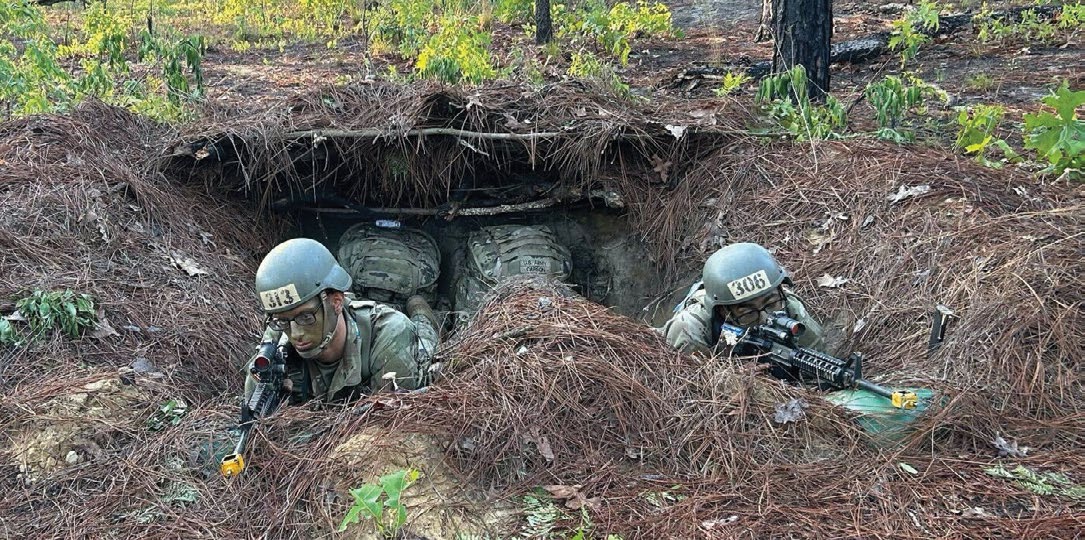
Trainees in the 193rd Infantry Brigade man a fighting position at Fort Jackson, SC. (Photo
courtesy of the 3rd Battalion, 60th Infantry Regiment)
In a message to our Army team on 26 October 2023, GEN Randy A. George, the 41st Army Chief of Staff,
reinforced that our enduring purpose as a force is to fight and win our nation’s wars. He further stated
that to do this we must stay grounded and dedicate our energy in four focus areas: warfighting,
delivering combat-ready formations, continuous transformation, and strengthening the profession.
As
of 2022, Basic Combat Training (BCT) lacked a focus on sustained ground combat and failed to prepare new
Soldiers for large-scale combat operations (LSCO). It was challenging but concentrated on events rather
than tactical-based training which better prepares new Soldiers to fight and survive on the modern
battlefield. As the character of war changes, so must our training strategies, leader development, and
resulting culture.
Change is a difficult process, as “it’s the way we have always done it” clouds the thoughts of some practitioners
and creates roadblocks. By giving subordinate elements and external entities significant initiatives to own,
develop, and create solutions for, change becomes less about the new idea from “them” and more about how “we”
make things the absolute best that they can be.
Throughout 2023, the 193rd Infantry Brigade at Fort Jackson, SC, focused heavily on creating a warfighting
mindset and culture within our trainees and cadre. This transition aligned with GEN George’s vision of bringing
warfighting back to the forefront of our profession and was already in motion within Initial Military Training
(IMT) when he became the Army Chief of Staff. Due to the changing character of war, MG John D. Kline, the
commanding general (CG) of the U.S. Army’s Center for Initial Military Training (CIMT), envisioned a BCT
environment that immersed cadre and trainees within a scenario-driven LSCO environment. This vision was further
discussed with IMT senior leaders for several months before MG Jason E. Kelly, the CG of Army Training Center
and Fort Jackson (ATCFJ), tasked the 193rd Infantry Brigade to develop a BCT training concept that better
prepared new Soldiers for LSCO. MG Kelly’s guidance focused on increasing individual survivability and ensuring
that the nation’s largest BCT enterprise was not only “Making American Soldiers” but “Making Our American
Soldiers Better.” This evolution, envisioned by MG Kline, embraced by MG Kelly, and operationalized as Forge 2.5
by the 193rd Infantry Brigade, focused on warrior tasks and battle drills (with a primacy on marksmanship),
tactical discipline, grit, physical fitness, and teamwork. This field training exercise (FTX) is executed within
a 72-hour, scenario-driven format and led by drill sergeants.1 We aimed to produce not just Soldiers but incredibly proud warfighters who
were ready and able to be value added to our profession’s purpose and ready to fight and win our nation’s wars.
As recently attested to by a battalion command sergeant major in the 193rd, “We’re now running continuous
operations in austere conditions, and you can almost see a company of light Infantrymen by the time we get them
back to Hilton Field. They’re tired, dirty, hungry — and most importantly, proud of what they were able to
accomplish over those 72 hours. I include our drill sergeants in that pool of people as well. You can clearly
see the amount of pride they have during the Soldier Induction Ceremony when they’re slapping ‘Star’ patches on
new Soldiers.” Forge 2.5 is not about a change to the program of instruction (POI). It’s about a change in
mindset, through which we are creating a warfighting culture among trainees and cadre. Simply put, Forge 2.5
puts the “C” back in BCT!
Refocusing on Warfighting
The process within the 193rd Infantry Brigade began in early April 2023 with a brigade commander/command sergeant
major (CSM) whiteboard session and the establishment of the Forge 2.5 operational planning team (OPT). This
council was made up of senior drill sergeants from each of the five BCT battalions in the brigade and led by a
company commander from the 2nd Battalion, 13th Infantry Regiment. This group of experienced professionals met
throughout that month, operating with initial guidance from the brigade commander to embed a tactical focus,
defined as noise and light discipline, personal and positional camouflage, to-standard fighting positions,
security, and situational awareness within the Forge with drill sergeants, fulfilling the roles of squad leaders
and platoon sergeants, leading trainees through. Battalion staffs were to deploy to the field to establish
tactical operations centers and perform their duties in a quasi-wartime manner. Every Forge iteration was to be
evaluated utilizing training and evaluation outlines (T&EOs) by a brigade-level evaluation team to enable
continued refinement through each battalion-level execution. The Forge was to remain 72 hours in duration and
all POI tasks were to be completed, but significant work was needed to transition the existing event-driven
administrative exercise into a true tactical FTX built around a LSCO scenario.
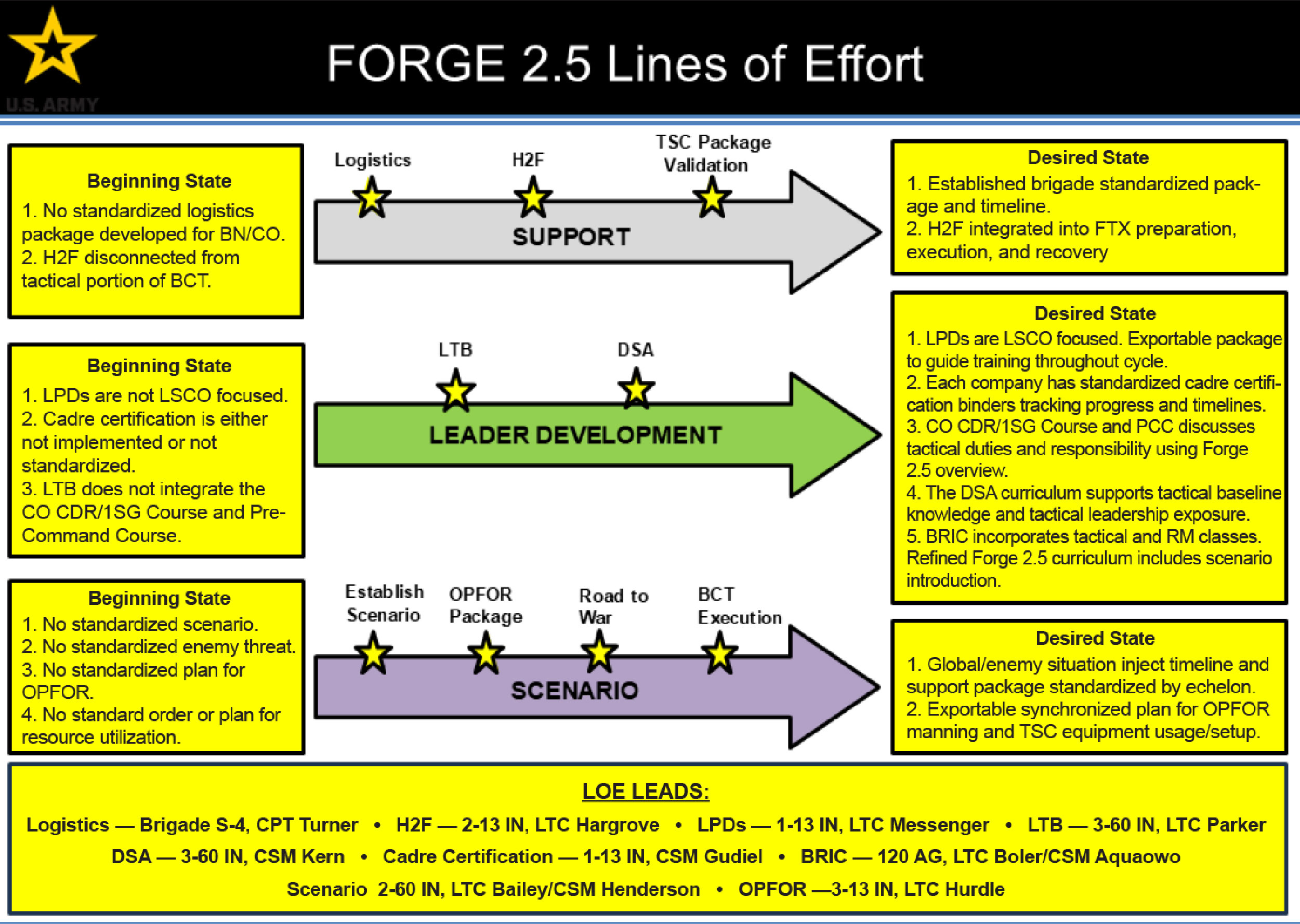
Figure 1 — Forge 2.5 Lines of Effort
The OPT developed a viable plan and briefed it to the brigade commander and CSM on 27 April 2023. The important
work conducted by the OPT’s NCOs started to steer the aircraft carrier into the necessary direction. The first
and second iterations of the transitional Forge were conducted by 2-13 IN, and 2nd Battalion, 60th Infantry
Regiment from 15-18 May and 10-13 July 2023 respectively. They were not without serious setbacks though; the
most significant of which were the identification of structural shortcomings within the brigade and a
realization of major deficiencies in the basic tactical knowledge of our cadre. We addressed these by developing
lines of effort (LOEs) focused on increasing structural support to the battalions and the tactical competence of
the cadre.
The brigade executive officer led the staff in the development of three broad LOEs that were identified as
essential in moving forward with the Forge 2.5 process. (See Figure 1). The LOEs served two major roles: to push
the brigade from current state to desired state and to design an improved Forge with input from as many
stakeholders as possible while using as many of our mission-enhancing resources as practical. This process,
although cumber some at times, gave every battalion within the brigade (as well as key stakeholders external to
the brigade) an active role in the transformation process. The result of this approach was increased
understanding, a sense of extreme ownership, and a culture that encouraged and incentivized creativity and
proactive solutions. What began as the vision of the CIMT CG was operationalized with input from six battalions
and many entities external to the brigade, and thus the initiative became transformational vice transactional.
As the brigade iterated through executions of the Forge with each battalion, the lack of an overarching
LSCO-focused scenario proved to be problematic. It prevented the creation of realism and detracted from the
purpose of the enhanced FTX. The U.S. Army Training and Doctrine Command (TRADOC) G-2 became the brigade’s main
effort for enabling the achievement of training realism and scenario immersion. Coordination between the 2-60 IN
command team and the TRADOC G-2 led to the development of an overarching global scenario, informed by the
National Defense Strategy, that provided the operational framework, through the backdrop of a series of nine
scenario injects that added training realism and tactical purpose to every BCT event, starting with reception
(see Figure 2).
In addition to the important LSCO scenario contributions, 2-60 IN developed the brigade’s overarching friendly
situation and the battalion linear defense concept. This was not without debate within the brigade, but a
standardized execution enabled a quicker organizational transition and provided for more accurate and consistent
evaluations. Henceforth, every 193rd unit conducting the Forge, except for 3-60 IN, would establish a battalion
linear defense.
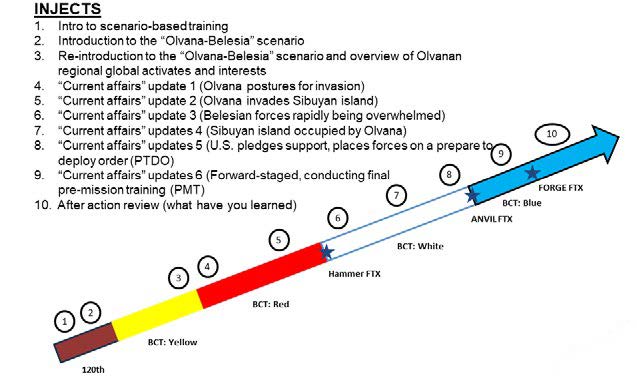
Figure 2 — Overview of Forge 2.5 Scenario Inject
From the outset, MG Kelly was laser focused on ensuring the exportability of the Forge 2.5 concept. Out of the
three major BCT installations (Fort Jackson; Fort Leonard Wood, MO; and Fort Sill, OK) only Fort Jackson
operationalizes BCT at the battalion level. This makes Fort Jackson’s throughput much greater but also puts a
battalion commander, CSM, and the requisite support staff on top of every Soldier’s initial military training
experience. The differences between levels of command involved created some skepticism to this initiative at
first. The 3-13 and 3-60 IN commanders conducted site surveys at Fort Leonard Wood and Fort Sill respectively to
better understand their operating conditions and procedures. From their visits, the brigade acquired a wealth of
knowledge that enabled them to meet the export ability intent. Accordingly, over the course of two BCT cycles,
3-60 IN developed and implemented a concept by which four companies operated detached from the battalion
throughout the execution of the Forge and its preparatory tactical FTXs. This important initiative proved that
the support received by the battalion headquarters could be provided at echelon by the company, and that the
level of command in control of the exercise had no measurable impact on the focus, training value, or
supportability of Forge 2.5.
The 120th Adjutant General (AG) Battalion is charged with receiving and in-processing upwards of 30,000
civilians annually who are destined for both the 193rd and 165th Infantry Brigades. Under the legacy BCT
culture, the 120th AG was where Fort Jackson welcomed civilians into the Army. As the warfighting
culture within BCT began to root and develop, the battalion identified an opportunity to introduce the
newly arrived civilians into the concept of scenario-based training, begin the LSCO scenario immersion,
and more appropriately welcome these new trainees into their future warfighting profession. Scenario
injects, battle-focused discussions, and physical training were easily threaded into the standard
reception tasks to immediately provide a stronger sense of purpose and increased excitement and pride
about what these trainees had committed to accomplish over the next 10 weeks.
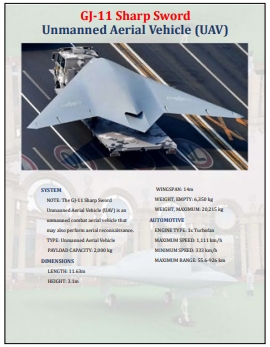
Figure 3 — Example Propaganda Poster Developed for Forge 2.5
While working to transform how we welcome civilians into our warfighting profession, the 120th AG also refocused
the brigade’s permanent party onboarding mechanism, the Bayonet Reception and Integration Course (BRIC). It took
a multi-day event that served as an administrative onboarding of new cadre members and completely revised it by
adding blocks of instruction on rifle marksmanship, holistic health and fitness (H2F), and the Forge 2.5
scenario and expectations. This effort, coupled with the refined reception initiative, began to plant the
warfighting mind set in trainees and cadre before even arriving to BCT.
The 120th’s renewed focus on onboarding warfighters created a desire to revisit our standardized handoff
mechanism — structured and disciplined pickup. The handoff between reception and the BCT battalions has morphed
through the years, but the standard at ATCFJ developed into an extremely professional event focused on Army and
unit history, discipline, and Army Combat Fitness Test demonstrations. With the newly found emphasis on
warfighting, this event again changed, but this time with the addition of instilling our Army’s warfighting
purpose. The Army and unit histories were maintained as a means of ensuring ongoing education on the important
feats accomplished by those who had previously filled the ranks of BCT while also applying these important
lessons learned to the present and connecting the new crop of trainees to the Army’s future. Adding a
LSCO-driven scenario into the disciplined pickup affords drill sergeants an early opportunity to introduce the
unit’s history and lead trainees through physically demanding tactical tasks. The early inculcation enables
their absolute connection to the Army’s past and future. Through the introduction to the tactical scenario and
our warfighting profession in reception, built upon through a refined structured and disciplined pickup, and
then codified throughout BCT, realism, purpose, and pride emerged to replace anxiety and confusion.
As in any tactical FTX, the presence and realistic use of opposing forces (OPFOR) within Forge 2.5 became
essential. The enemy concept, created by the TRADOC G-2, called for a Southeast Asia-focused threat situation
with a fictitious country named Olvana. With the assistance of the Fort Jackson Training Support Center (TSC),
3-13 IN developed and sourced a complete package of OPFOR support items: tiger stripe uniforms, pneumatic guns,
improvised explosive device (IED) simulators, and a full complement of Kalashnikov assault rifles (AK-47s),
Soviet-type light machine guns (RPKs), and rocket-propelled grenade (RPG) launchers. With the equipment packages
sourced and built, the team developed what became the brigade’s tactics, techniques, and procedures (TTPs) for
OPFOR utilization, including element size, where they are sourced from, tactical control, scenario control, and
day-by-day OPFOR mission sets to ensure the training objectives were achieved. Scenario immersion was further
solidified by 3-13 IN’s creation of more than 20 World War II-inspired propaganda posters (see Figure 3). These
were devised and designed by the battalion, produced by TSC at Fort Eustis, VA, and posted around the BCT
battalion and company areas on Fort Jackson to immerse trainees in a realistic and well-sourced scenario that
provides added benefit to, and purpose for, every training event within BCT.
Strengthening the Profession
The quest to better prepare our cadre focused internally through the development of a LSCO-focused leader
professional development (LPD) program, led by 1-13 IN. They developed a holistic plan that progressed weekly
throughout cycle reset and the weeks of BCT leading up to the Forge. This LPD plan provided cadre the education
necessary to break the mold produced by 20 years of the global war on terrorism (GWOT). It enabled them to think
and act in preparation for the next war instead of being anchored to the lessons learned from the GWOT.
Simultaneously, 1-13 IN worked diligently to identify the key tasks that were imperative for cadre to master.
This resulted in the creation of a certification process that succeeded in enabling all cadre, no matter their
military occupational specialty (MOS), to embody competence and confidence as tactical leaders.
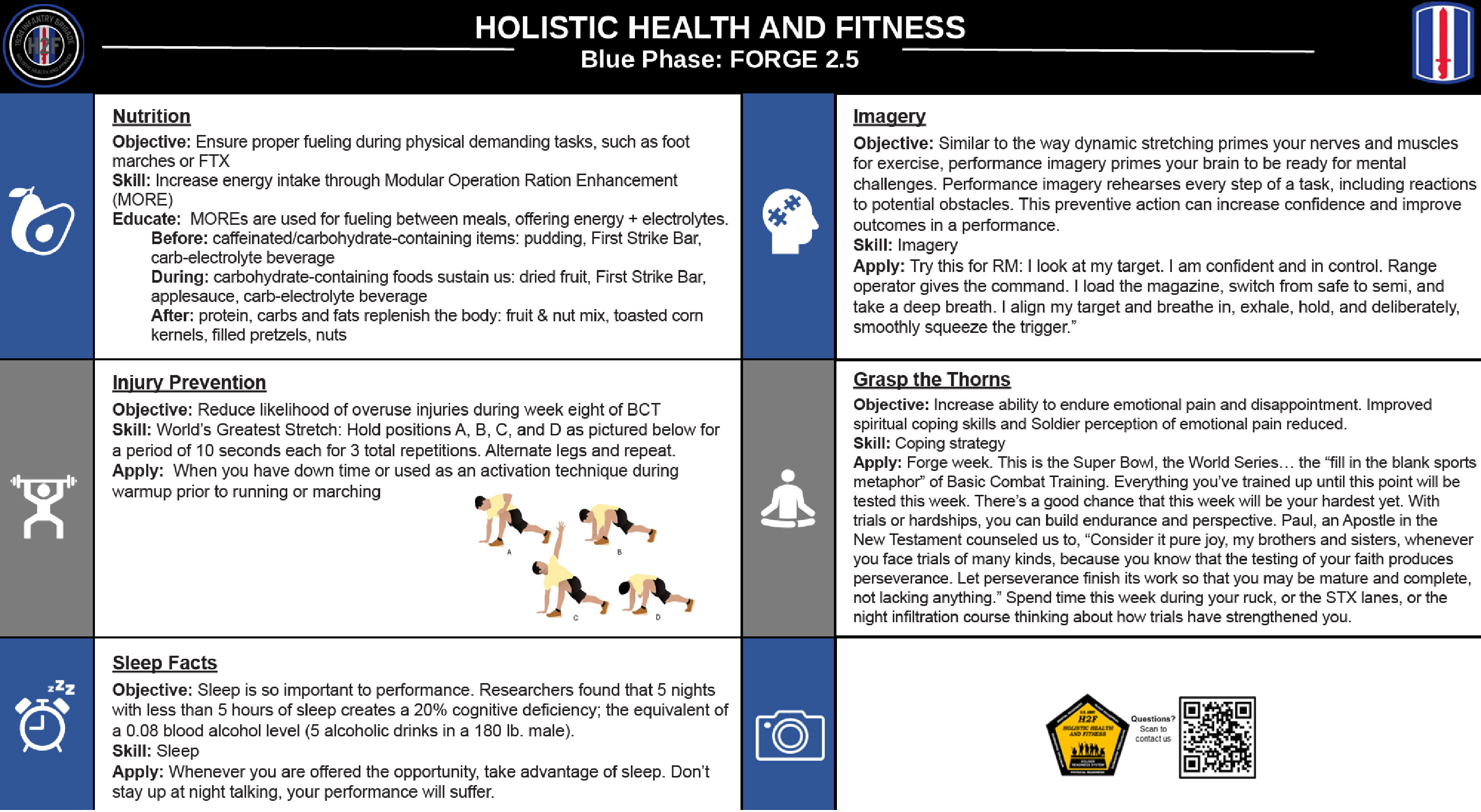
Figure 4 — H2F Training Strategy
Although the leadership within the brigade developed effective solutions to the immediate concerns uncovered from
our initial iterations of Forge 2.5, lasting change would require education of new cadre members before they
were to fill their important roles within BCT. LPDs and cadre certification were enough to get us back on track,
but foundational change in our future cadre, instituted through the Leader Training Brigade (LTB) and the U.S.
Army Drill Sergeant Academy (USADSA), was necessary to create the “competence to be confident” across every IMT
installation. These efforts were spearheaded by 3-60 IN.
Drill sergeants are masters of training the POI and have been finely honed by the USADSA to expertly train basic
Soldier skills. However, without a focus on tactical leadership and survivability in LSCO, we had asked our
drill sergeants (and company command teams) to enter a realm where they weren’t competent enough to be
confident. There existed a grave delta between what our cadre knew and understood about tactical leadership and
where we were demanding that they go during Forge 2.5. Tactical leadership across the cadre spectrum was
integral to bringing realism and relevance into training, and the brigade’s initial Forge 2.5 iterations
uncovered a need for significant cadre investment.
The 3-60 IN worked hard refining and establishing the means to fully prepare the battalion’s cadre to excel as
tactical drill sergeants (as squad leaders and platoon sergeants leading trainees in simulated combat). Their
experiences were enthusiastically received by the USADSA. With 3-60 IN’s assistance, USADSA staff members
immediately identified where they could evolve training and education to produce not only a better drill
sergeant but a better NCO who was ready to lead trainees in a tactical environment. Similarly, 3-60 IN Soldiers
worked with LTB to investigate their portfolio and identify where they could assist with the endeavor. LTB’s
offerings, the TRADOC Company Commander and First Sergeant Course and the TRADOC Pre-Command Course, provided
other essential venues to educate on and market the growing tactical focus in BCT. LTB developed and refined
blocks of instruction to better prepare incoming command teams for the new training environment. The efforts
with the USADSA and LTB, led by 3-60 IN, resulted in institutional change that ensured cadre and leader training
evolved at pace with the changing character of war.
H2F is a powerful weapon in the Soldier’s arsenal, the application of which makes them the absolute best versions
of themselves possible. As the brigade sought to create irreversible change in the mindset of those within the
unit, it became apparent that cadre/trainee investment in each of the five H2F domains (Mental, Sleep,
Nutritional, Physical, and Spiritual) was necessary to reach peak performance due to the stress created by 72
hours of simulated combat. Not only would this prepare them for Forge 2.5 and empower them throughout execution,
it would also facilitate post-execution recovery. The 2-13 IN, in conjunction with the 193rd’s H2F Team, led the
operationalization of H2F as a mission-enhancing element of our Forge 2.5 transition. This effort started by
immersing our H2F team within the BCT environment throughout the cycle while simultaneously instituting full
five-domain assessments on the brigade’s entire cadre population. The assessments educated cadre on their
performance blind spots, while the immersion enabled the H2F team to assess the physical and mental demands on
both trainees and BCT cadre. Once the subject matter experts understood the stressors on both cadre and
trainees, they were able to devise a training strategy to increase performance, not just in Forge 2.5 but
throughout BCT (see Figure 4). This led to many supporting H2F initiatives, all geared towards increasing
individual and collective performance, developing a strong sense of a warfighting purpose, increasing confidence
through competence, and strengthening the sense of team at every echelon.
Continuous Transformation
After nearly nine months and almost 15 iterations of Forge 2.5, the 193rd Infantry Brigade had achieved a
complete transition. Throughout the process, leaders at every echelon within the brigade laid a substantial
foundation of tactical knowledge and capability within their cadre. The combination of the BRIC, LPDs, cadre
certification, and USADSA and LTB instructional modifications, assessments, and battalion/ company-level
training improvements laid the groundwork for the added complexity that was necessary to complete the
LSCO-focused transition and incorporate lessons learned from the ongoing war in Ukraine such as the use of small
unmanned aerial systems (sUAS).
Since their first usage in the GWOT, sUAS have continued to become ever more present throughout global conflicts.
From Syria to Ukraine, sUAS have proven to be a normal aspect within modern warfare, and with that, they have
reinforced the need for the basic tactical skills that Forge 2.5 produces as part of the foundation of our
warfighters. The inclusion of sUAS in BCT provided a means by which cadre could train and reinforce foundational
tactical skills, using real-world threat scenarios to provide the “why” behind tasks inherent to individual
survival on the modern battlefield. Reacting to sUAS is as important to the individual Soldier today as the
GWOT’s signature “5s & 25s” were to individual avoidance of IEDs in Iraq and Afghanistan.
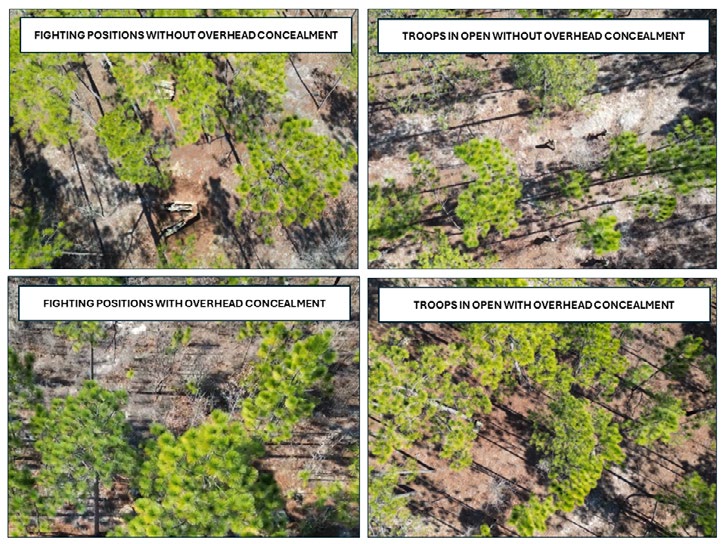
Figure 5 — Photos from sUAS of Trainees during Forge 2.5
The 193rd’s quest for realism and relevance through the inclusion of sUAS began with cross talking and visits
with the 197th and 198th Infantry Brigades, as well as cadre from the U.S. Army Sniper Course, all under the
Maneuver Center of Excellence at Fort Moore, GA. The 197th and 198th conduct Infantry One Station Unit Training
(OSUT) and have spearheaded sUAS usage within their training evolutions for almost a year. The OSUT brigades
shared valuable lessons learned with reference to gaining approval for sUAS in the airspace, training of
operators, and the implementation of sUAS in training. Additionally, they developed and implemented the first
react to sUAS battle drill for usage in OSUT, which sparked further refinement and development for usage at BCT.
Furthermore, they trained and certified ATCFJ’s first operators (one from each brigade). The U.S. Army Sniper
School assisted 193rd leadership with understanding how best to defeat detection through the application of
basic tactical skills, such as personal and positional camouflage, noise and light discipline,
cover/concealment, situational aware ness, security, and proper tactical movement (all important basic tasks to
be trained in BCT).
Open-source lessons learned from Ukraine illustrate sUAS being used primarily in two ways: to identify adversary
formations and to drop munitions or spot for artillery. The 193rd’s use of sUAS within Forge 2.5 followed these
two tactical applications, and hence, our mitigation techniques focused towards diminishing a sUAS’s ability to
identify forces to target. This was conducted primarily through rein forcing the foundational tactical standards
called for initially in Forge 2.5: noise and light discipline, personal and positional camouflage, to-standard
fighting positions (including overhead concealment), security, and situational awareness (SA). The brigade
developed two reactions to sUAS that were passive in nature, did not call for engaging the plat forms, and
required no specialized equipment or skills. These reactions address the types of sUAS contact in the individual
Soldier task framework that is essential in BCT (see Figure 5). In a defensive scenario, the emphasis was put on
overhead concealment using natural vegetation. While patrolling or stationary in the open, vertically aligning
oneself against a tree trunk enabled the usage of the tree’s branches to conceal the Soldier from observation.
While “seeking cover” oftentimes involves laying prone, in a sUAS scenario a horizontal body is much easier to
observe from the air than a vertical one.
Delivering Combat Ready Soldiers
By incorporating a LSCO scenario and continuous tactical operations, the Forge became purposeful, realistic, and
more challenging; ensured a firmer foundation of basic skills within our trainees; and empowered our cadre and
staffs to develop as leaders. By focusing on the foundational tactical skills of noise and light discipline,
personal and positional camouflage, to-standard fighting positions, security, and situational awareness
(including SA of aerial threats), it creates an entry-level Soldier with the skills inherent to survive on the
modern battlefield.
As the process began, it was evident that change within a TRADOC BCT brigade materialized like the turn of an
aircraft carrier. But serious change needed to happen, and it needed to take place on a compressed timeline much
more like the turn of a speed boat. Every BCT cycle that graduated before we could accomplish it was another
800-1,200 new Soldiers that were not prepared for the wars that might lie ahead. They would be disciplined and
fit yet would lack the tactical foundation necessary to survive in LSCO. A team comprised of these Soldiers
would be sub-optimal on the modern battle field, regardless of their combat mission.
As illustrated throughout the preceding text, creating a warfighting mindset in BCT was a whole of brigade
effort. Every battalion had an essential piece of the initiative. Change started with guidance from a few but
was planned for, refined, and operationalized by a brigade staff, six incredibly talented battalion command
teams and their respective formations, as well as a few key external stake holders (USADSA, LTB, TSC).
These types of initiatives are difficult and not without resistance from cadre who operated under the antiquated
and process-driven FTXs. A clear vision and initiative ownership at the lowest echelons are essential to trans
formational change, both increasing relevancies now and in the future. This process has created incredibly proud
warfighters who are ready, able, and capable of taking on the responsibility of our Profession of Arms to fight
and win our nation’s wars.
Notes
1. Emphasis added to highlight a major shift in how drill
sergeants operate. A key aspect of this warfighting focus is drill sergeants leading as squad leaders and
platoon sergeants. As they transition from trainers to leaders, they show trainees true NCO leadership and
what it can accomplish.
Authors
At the time this article was written, COL Scott C. White served as the commander of the
193rd Infantry Brigade at Fort Jackson, SC. He currently serves as the U.S. Army Special Operations Command
G-3. His former assignments include serving as the assistant chief of staff, G-3 for the United States Army
John F. Kennedy Special Warfare Center and School; commander of 6th Battalion, 1st Special Warfare Training
Group (Airborne); operations officer for 2nd Battalion, 3rd Special Forces Group (A); commander of Delta
Company, 2nd Battalion, 1st Special Warfare Training Group (A); and commander of Charlie Company, 2nd
Battalion, 3rd Special Forces Group (A). COL White holds a Bachelor of Arts in political science from The
Citadel, a Master of Science in defense analysis (irregular warfare) from the Naval Post-Graduate School,
and a Master of Strategic Studies from the U.S. Army War College.
CSM Jonathan M. Duncan currently serves as the command sergeant major of the 193rd Infantry
Brigade. His former assignments include serving as command sergeant major of 1st Battalion, 34th Infantry
Regiment; operations sergeant major in 1st Battalion, 6th Infantry Regiment; operations sergeant major in
3rd Squadron, 2nd Cavalry Regiment; first sergeant of Iron Troop, 3-2 CR; and first sergeant of Headquarters
and Headquarters Company, 1st Battalion, 29th Infantry Regiment. CSM Duncan holds a Bachelor of Science in
organizational leadership from the University of Louisville and a Master of Science in human resources and
organization development.